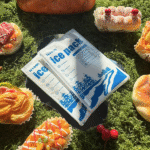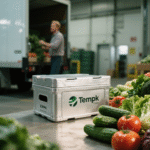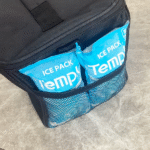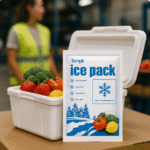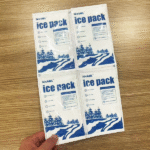Beim Versandtemperaturempfindlichkeitsprodukte, Es ist wichtig, die richtige Kühlmethode zu wählen, um sicherzustellen, dass die Artikel in optimalem Zustand bleiben. Two of the most commonly used cooling solutions in cold chain logistics are dry ice and gel packs. This article will compare the two options, exploring their differences, Vorteile, and which one is best suited for your specific shipping needs.
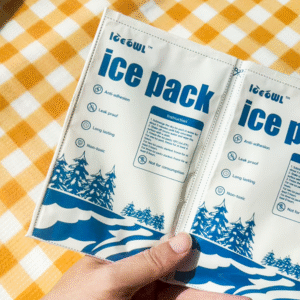
Schlüsselunterschiede zwischen Trockeneis und Gelpackungen
-
Trockeneis: Sublimiert bei -78,5 °C (-109.3° F), ideal for ultra-low-temperature needs.
-
Gelpackungen: Keep temperatures typically between 0°C and 10°C, geeignet für gekühlte Ware.
Was ist Trockeneis und wie funktioniert es??
Trockeneis ist festes Kohlendioxid (CO2) that sublimates at a very low temperature. It is commonly used for shipping pharmaceuticals, gefrorenes Essen, und biologische Materialien. Im Gegensatz zu normalem Eis, Trockeneis untermauert direkt in Gas, hinterlässt keine Rückstände. This makes it an efficient and clean cooling agent, especially for products that require extremely low temperatures.
Benefits of Using Dry Ice in Cold Chain Logistics
-
Extreme Cooling Efficiency: Dry ice maintains temperatures far below freezing.
-
Kein Rest: Es untermauert, leaving no liquid behind, which is beneficial for sensitive products.
-
Längere Kühldauer: Properly packed, it can maintain low temperatures for extended periods.
Drawbacks of Dry Ice
-
Sicherheit im Umgang: It requires special handling due to the risk of burns and asphyxiation from CO2 gas.
-
Shipping Restrictions: Dry ice is subject to strict shipping regulations.
-
Risk of Freezing: Its extreme cooling power can potentially damage temperature-sensitive products if not managed correctly.
What are Gel Packs and How Do They Work?
Gel packs are flexible pouches filled with a gel that freezes and releases cool temperatures. These packs are typically used for moderate cooling needs, making them ideal for items such as fresh produce, Kosmetika, and flowers.
Benefits of Gel Packs in Cold Chain Logistics
-
Safer to Handle: Im Gegensatz zu Trockeneis, gel packs do not pose a risk of burns or asphyxiation.
-
More Versatile: They are available in various sizes and offer customizable cooling power.
-
Kostengünstig: Gelpackungen sind im Allgemeinen günstiger, insbesondere für kurzfristige Sendungen.
Drawbacks of Gel Packs
-
Begrenzte Kühldauer: They are not as effective for long-distance shipments or ultra-low-temperature needs.
-
Potential for Leaks: Im Laufe der Zeit, gel packs can degrade and leak.
-
Less Intense Cooling: Not suitable for products that need sub-zero temperatures.
How to Choose Between Dry Ice and Gel Packs for Cold Chain Shipping?
The choice between dry ice and gel packs depends on several factors:
-
For Extreme Cold: If your products need to stay below freezing for extended periods, Trockeneis ist die beste Option.
-
For Moderate Cooling: Gel packs are more suitable for products that only need to be kept cool, nicht gefroren.
-
Sicherheitsüberlegungen: Gel packs are safer to handle, whereas dry ice requires special precautions due to the CO2 gas.
-
Kosteneffizienz: Für kurzfristige Sendungen, gel packs are generally more cost-effective, while dry ice is better suited for long shipments where extended cooling is necessary.
Packaging and Safety Tips
-
Trockeneis: Use insulated containers and ensure proper ventilation during transportation. Always comply with shipping regulations for dry ice.
-
Gelpackungen: Pre-chill both the gel packs and the items being shipped. Layer the gel packs for even cooling distribution.
2025 Trends in der Kaltkette -Logistik
Latest Advancements in Cold Chain Solutions
Mit 2025 approaching, there is a growing trend toward energy-efficient cold chain solutions. New materials and technologies, such as smart packaging and phase-change materials (PCMs), are emerging to offer better temperature control and sustainability.
-
Intelligente Verpackungen: Temperature sensors are now integrated into packaging, providing real-time monitoring of conditions.
-
Nachhaltigkeitsfokus: Companies are increasingly adopting eco-friendly solutions, including biodegradable gel packs and energy-efficient refrigeration technologies.
-
Ai & Automatisierung: AI is improving the accuracy and efficiency of cold chain logistics, reducing human error and waste.
Safety and Environmental Considerations
Both dry ice and gel packs come with unique environmental impacts:
-
Trockeneis: Produces CO2, ein Treibhausgas, Während der Sublimation. Jedoch, it is more efficient for extreme cooling.
-
Gelpackungen: Many gel packs are reusable and made from recyclable materials, making them a more sustainable option for the environment.
FAQ
Q1: How long can dry ice keep products frozen?
Trockeneis kann die Gefriertemperaturen bis zu halten 72 Std., depending on factors like the amount used and insulation quality.
Q2: Sind Gelpakete wiederverwendbar?
Ja, Gelpackungen sind wiederverwendbar, making them a cost-effective option for frequent shipments.
Q3: Can gel packs be used for long-distance shipping?
Gel packs are better suited for short shipments. Für längere Dauer, dry ice is more effective.
Schlussfolgerung und Empfehlungen
Choosing between dry ice and gel packs ultimately depends on your shipment’s requirements. For ultra-low temperatures and extended durations, dry ice is the superior option. For moderate cooling needs and short shipments, gel packs provide a safer, more cost-effective solution. Be sure to evaluate your product’s sensitivity, Versanddauer, and safety requirements to make the best choice.
Über Tempk
Tempk is a leader in cold chain logistics solutions, providing advanced cooling technologies to ensure the safe and efficient transportation of temperature-sensitive products. Contact us for expert advice on optimizing your cold chain logistics with dry ice, Gelpackungen, and other innovative solutions.
















